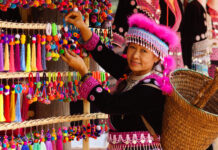The languages of Edo
Text by Sophie Ibbotson
Today it is Tokyo but once, many lifetimes ago, the same city was Edo, the imperial capital of Japan. Amidst the marks of modernity – the skyscrapers, the flyovers and the neon signs – are hidden hints of a world many think are lost, but which are just waiting for the eagle-eyed to discover.
Together with Satoko Hirakawa, my walking tours guide, I stand upon the Nihonbashi Bridge, looking in the direction of Mount Fuji. High-rise buildings now obscure the view, but as an ancient milestone by our side shows, this was once point zero on the map. In Europe, they say all roads lead to Rome; here in Japan, it was Edo that was the central hub of the wheel. The calligraphy, cut into dark grey granite, was still crystal clear despite the centuries that had passed since its carving. The characters, sharp yet elegant in their form, simply stated the most important cities in Japan, and the distances to get there. Nihonbashi Bridge was the gateway into and out of Edo, and this stone marked how far travellers still had to go on their journey, or how far they had come.
Tokyo has not forgotten its past. In the backstreet alleys, and amidst the temple gardens and shrines, the Edo period (1603–1868), the heyday of the samurai, comes to life.

The Warrior Class
The samurai were the warrior clans of medieval Japan, immortalised in literature and in art. Living in accordance with strictly-regulated codes and dressed in distinctive costumes, the samurai enthralled all those who heard about them and their stories about travelling around the world. In the Edo period, the samurai were predominantly civil servants and courtiers, as it was a relatively peaceful time. Court life centred on Edo’s imperial palace, Edo Castle, in the central part of modern Tokyo. Here in the vast, walled complex with a moat, among the imposing stone towers and guardhouses, they refined the high culture for which Japan is renowned.
Cultural inspiration came from many sources. Dutch traders in Dejima, an island in the Bay of Nagasaki, brought western texts about science, geography, languages and medicine. At the same time, Confucianism, once the preserve of Buddhist clerics, burst forth in a new form, neo-Confucianism, and its humanism and rationalism appealed strongly to the samurai and to the mercantile classes who were gaining status in society.
A Prominent Samurai
At the forefront of neo-Confucian thought was a samurai, Yamaga Sokõ (1622–1685). He was a military strategist and a scholar, and a philosopher and a classicist, too. For Yamaga, the peaceful arts, letters and history were essential components of intellectual discipline, and these priorities are reflected in his writings, The Way of the Samurai.
Yamaga’s contemporary, Kaibara Ekken, realised, however, that the Confucian and neo-Confucian texts were completely inaccessible, even to many educated Japanese. Therefore, he made it his lifetime’s work to translate these complex religious and philosophical texts into vernacular Japanese. Fondly called the ‘Aristotle of Japan’ by 19th-century Japanologists, Kaibara translated Confucian ethics into simple, self-help manuals, with titles such as Precepts for Children and Greater Learning for Women. In doing so, he not only enriched the canon of Japanese literature, but also brought complex philosophical ideas within the reach of ordinary people, expressing them in language they could understand.
A Golden Age
Indeed, the Japanese language itself, not just the ideas it was used to express, was changing in the Edo period, too. Even as the Edo period began, foreign loan words, especially from Portuguese, were creeping into local vocabulary: newly-imported products such as tobacco and bread required new words. Japan’s period of isolation did slow the arrival and adoption of foreign words, but their rate of acquisition accelerated again after 1853 when these isolationist policies were dropped. Modern concepts and modern technologies required words to describe them, and the easiest way to do this was to adopt their European names.
The dialects of Japanese used during the Edo period changed too, and this was due in large part to the geographic shift of the imperial capital from Kyoto to Edo. Whereas previously the Kamigata dialect had been most influential, now that economic growth, artistic development, and political importance centred on Edo meant that the Edo dialect – the ancestor to today’s Tokyo dialect – came to the fore, and it underpinned early modern Japanese. There was a certain amount of rivalry between the dialects and the people who spoke them: the Edokko (those born and raised in Edo) could identify aristocrats from Kyoto, merchants from Osaka, and ‘peasant’ samurai from the countryside, by their speech, and tended to look down on them as less sophisticated,
less urbane.

The End of an Era
By the 18th century, the samurai no longer saw themselves primarily as warriors or landowners, but as scholar administrators in a highly-developed system of government. Political stability and a strong economy supported the pursuit of intellectual disciplines, the development of literature and the arts: the search for enjoyment. Painting and print making flourished, spreading knowledge. Folk songs and legends, historic treatise, texts about science and anatomy, and religious works all found wide and receptive audiences.

When the Meiji Emperor was restored in 1868, the samurai came to an end in all bar name. Japan’s new rulers were keen to force the pace of change. Edo’s Golden Age of knowledge, linguistic development, literature and the arts was swept away in favour of modernisation, westernisation and industrialisation, but, the samurai – educated, politically astute, and often having knowledge of commerce – found new roles in business, administration and the press. They were well placed to take Japan into the 20th century.
For more stories and photographs from this issue, check out Asian Geographic Issue 120.











